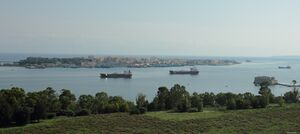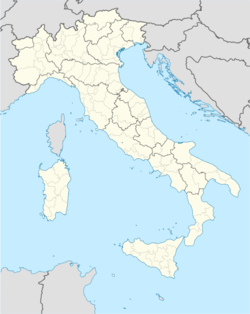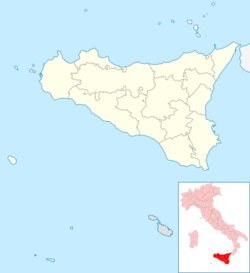أوگوستا، صقلية
Augusta | |
|---|---|
| Comune di Augusta | |
 | |
| الإحداثيات: 37°15′N 15°13′E / 37.250°N 15.217°E | |
| البلد | إيطاليا |
| المنطقة | Sicily |
| المقاطعة | Syracuse (SR) |
| Frazioni | Agnone Bagni, Brucoli |
| الحكومة | |
| • العمدة | Maria Concetta Di Pietro ([[قائمة الأحزاب السياسية في إيطاليا|Five Star Movement]]) |
| المساحة | |
| • الإجمالي | 111٫16 كم² (42٫92 ميل²) |
| المنسوب | 15 m (49 ft) |
| التعداد (30 November 2017[1]) | |
| • الإجمالي | 35٬854 |
| • الكثافة | 320/km2 (840/sq mi) |
| صفة المواطن | Augustani |
| منطقة التوقيت | UTC+1 (CET) |
| • الصيف (التوقيت الصيفي) | UTC+2 (CEST) |
| الرمز البريدي | 96011 |
| مفتاح الهاتف | 0931 |
| Patron saint | St. Dominic |
| يوم القديس | May 24 |
| الموقع الإلكتروني | Official website |
Augusta (النطق بالإيطالية: [auˈɡusta];[2] Sicilian: Austa, Greek and Latin: Megara Hyblaea, Medieval: Augusta and Agosta) is a town and comune في مقاطعة سيراقوسة، الواقعة على الساحل الشرقي لصقلية (جنوب إيطاليا). المدينة هي واحدة من الموانئ الرئيسية في إيطاليا، خصوصاً لمصافي النفط (سوناطراك وغيرهم كجزء من مجمع أوگوستا-پريولو) الواقع على مقربة من المدينة.
الجغرافيا
The city is situated in the province of Syracuse and faces the Ionian Sea. The old town is an island, made in the 16th century by cutting an isthmus and is connected to the mainland by two bridges. One bridge was built recently[when?] (Viaduct Frederick II of Swabia) and the other built when the city was founded and is called the Spanish Gate. Augusta is home to two ports.
التاريخ
Founded 27 centuries ago, Megara Hyblaea is one of the oldest Greek colonies of Sicily. It was destroyed by its rival Syracuse, was raised from its ruins, then taken by the Romans together with Syracuse during the Second Punic War. It remains an archaeological site, a testimony of the organization of a Greek colony of the Archaic period.
Upon the ruins of one of its suburbs, Xiphonia, the city of Augusta was founded in 1232 by Emperor Frederick II. After the Angevin domination, it became part of Aragonese Sicily and, from 1362, it was a fief of Guglielmo Raimondo II Moncada. It returned to be a royal possession (under Spain) in 1560, and was extensively fortified to counter Turkish pirates.
In 1675 its harbour was the site of a naval battle between the Dutch-Spanish and the French fleets. The town suffered a major earthquake and tsunami in 1693.[3]
During World War II Augusta was a hotbead of anti-Mussolini sentiment and anti-fascist sentiment more generally, as was all of Sicily.[4] Because of the strongarm tactics that the Mussolini regime used to subdue Sicily, the fascist regime was very unpopular on the island, including in Augusta.[5] When British and American forces arrived in Sicily, the Sicilians did not regard them as conquering invaders but rather greeted them as "emancipators come to lift the evil burden of fascism from their shoulders."[6][7] All across Sicily the invading forces were greeted with relief and often with unbridled enthusiasm.[8]
During Operation Husky, the combined British and American effort to dislodge fascist forces from Sicily, the plan was for British forces under General Montgomery to capture Augusta during the first few days of the operation. This part of the operation went entirely according to plan and Augusta was captured on July 13, 1943, by the British Eighth Army, led by Britain's General Montgomery. Almost immediately thereafter British forces began moving north towards Catania.[9]
Main sights
- Castello Svevo (Hohenstaufen Castle, built c. 1232). It has a square plan of a 62-متر (203 ft) side length, with eight towers
- Capo Santa Croce Lighthouse
- Church of Anime Sante del Purgatorio (S. Nicolò). The Baroque façade is attributed to Filippo Juvarra
- Church of Carmine
- Church of Cristo Re
- Church of Maria Santissima Assunta (Augusta)
- Church of Maria Santissima del Soccorso
- Church of Sacro Cuore
- Church of San Domenico (13th century). The façade is in Neoclassical style
- Church of San Francesco di Paola
- Church of San Giuseppe
- Church of Santa Maria delle Grazie
- Church of Santa Maria del Soccorso
- Church of San Sebastiano
- Church of Sant'Andrea
- Church of Santa Lucia
- Convent of the Dominican Fathers
- Eremo Adonai
- Forti Garsia e Vittoria
- Hangar dirigibili Augusta
- Kursaal Augusteo
- Porta Spagnola
- Ricetta di Malta
- Spanish Gate (17th century)
- Torre Avalos
People
- Rosario Morello, engineer
- Emanuele d'Astorga, composer
- Danilo Conti, philosopher, astronaut
- Orso Mario Corbino, physicist
- Epicarmo Corbino, economist
- Giuseppe Di Mare (composer), organist, pianist and composer
- Rosario Fiorello, showman
- Beppe Fiorello, actor
- Alfredo Maria Garsia, Bishop of Caltanissetta
- Marcello Guagliardo Giordani, opera singer (tenor)
- Giovanni Lavaggi, Formula 1 driver
- Roy Paci, musician
- Antonio Scaduto, canoeist
- Riccardo Schicchi, director
- Chiara Strazzulla, writer
- Vintario Brusconti, writer (fictional)
- Francesco Saia, footballer, wine aficionado
انظر أيضاً

المصادر
- ^ Data from Istat
- ^ Luciano Canepari. "Augusta". DiPI Online (in الإيطالية). Retrieved 27 October 2018.
- ^ Catalogue of tsunamis generated in Italy and in Cote d’Azur, France:a step towards a unified catalogue of tsunamis in Europe, Stefano Tinti and Alessandra Maramai - 1693 1 9 - Eastern Sicily Anomalous sea movement at Augusta and 1693 l 11 - Eastern Sicily Large sea withdrawal and flooding at Augusta
- ^ The Christian Century, Volume 60 pg. 835
- ^ Sicily: An Informal History By Peter Smmartino, William Roberts pg. 111
- ^ Bitter Victory: The Battle for Sicily, 1943 by Carlo D'Este, pg. 433
- ^ Italy; an historical survey by Jack F. Bernard, published by David and Charles, 1971; pg. 476
- ^ Duggan, Christopher (June 2013). Fascist Voices: An Intimate History of Mussolini's Italy. ISBN 9780199338375.
- ^ Bitter Victory: The Battle for Sicily, July–August 1943 by Carlo D'este, pg. 310, 312, 325
وصلات خارجية
- Pages using gadget WikiMiniAtlas
- CS1 الإيطالية-language sources (it)
- Short description is different from Wikidata
- Articles containing إيطالية-language text
- Coordinates on Wikidata
- Pages using infobox settlement with image map1 but not image map
- Italian commune articles with missing parameters
- Vague or ambiguous time from March 2017
- مدن وبلدات في صقلية
- بلديات مقاطعة سيراقوسة
- صفحات مع الخرائط





